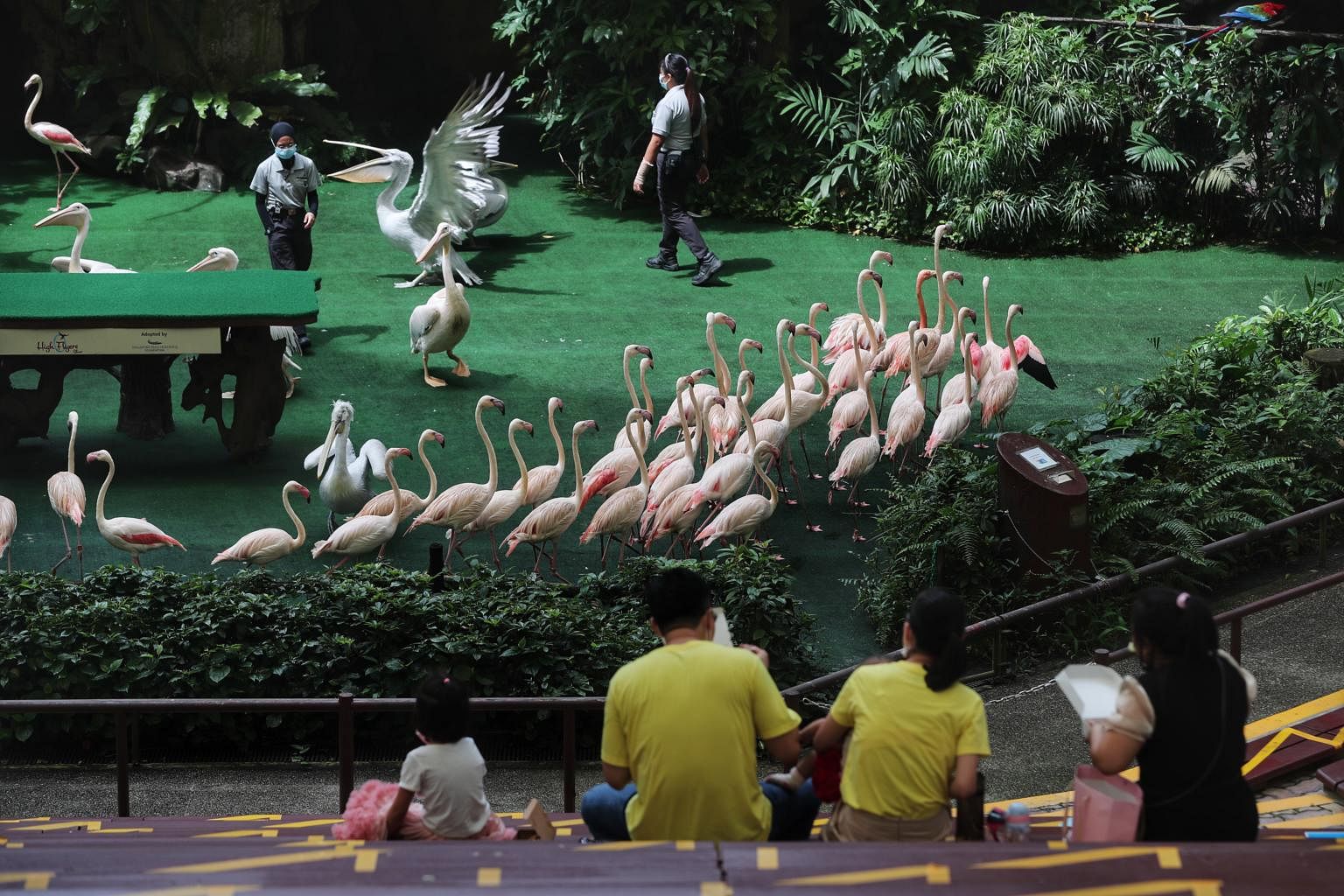One year after Singapore confirmed its first case of the disease, here's a look at the milestones in the nation's response to the pandemic.
Jan 23, 2020
• Singapore announces its first confirmed case of Covid-19 - a 66-year-old Chinese man from Wuhan, China.
Feb 7
• The Ministry of Health (MOH) raises the Dorscon level from yellow to orange, signalling that there is widespread transmission of Covid-19 from unknown sources. This is one level below the highest level of red, which signifies an out-of-control pandemic.
• Dorscon, or Disease Outbreak Response System Condition, is part of Singapore's pandemic preparedness plan and describes the current disease situation and what has to be done.
• Shortly after the Dorscon level is raised, there is a wave of panic buying. Items like instant noodles and toilet paper fly off the shelves and long queues form at supermarkets. The frenzy continues the next day even as politicians and supermarkets call for calm, stressing that Singapore has enough stocks of essential supplies and food.
• A year later, the nation's Dorscon level remains at orange.

Feb 18
• Budget Day. Deputy Prime Minister Heng Swee Keat unveils the Unity Budget, the first of four Budgets that will be rolled out in less than four months.
• Through the Budgets (Unity, Resilience, Solidarity and Fortitude) the Government dedicates close to $100 billion - or nearly 20 per cent of gross domestic product - to supporting Singaporeans and businesses in the battle against Covid-19.
• Help is in the form of cash for some Singaporeans, while businesses are assisted through Jobs Support Scheme payouts and rental relief. There is also assistance rendered for the lower-income and self-employed groups.
March 20
• The TraceTogether contact tracing app is launched. The app can identify, via wireless Bluetooth technology, people who have been within 2m of Covid-19 patients for at least 30 minutes. Tokens are later issued amid questions about the implications for privacy. Both the token and the app do not collect location data.
• It has since been revealed, however, that TraceTogether data can be used for police investigations, which has raised questions over trust in government, especially in relation to data privacy.
• The Government has announced that a law will be passed to ensure that this data, if needed for criminal investigations, can be used only to look into serious offences including murder, terrorism and rape.
March 21
• Singapore reports its first two Covid-19 deaths: A 75-year-old Singaporean woman and a 64-year-old Indonesian man.
• Though the country has kept its death rate impressively low, seniors remain a vulnerable group because they have a higher chance of developing severe complications from the coronavirus. This risk stems from several factors, including a weaker immune system and higher prevalence of multiple medical conditions, such as heart disease, diabetes and hypertension.
March 23

• Singapore sees a new peak in daily imported cases - around 50 a day.
• All short-term visitors are not allowed to enter or transit Singapore from 11.59pm on this day.
• A slew of measures are implemented in the weeks and months ahead. These have been tightened in the new year in response to new virus variants and the worsening global situation.
April 7
• Circuit breaker measures kick in - the most difficult and drastic step the Government has taken to date.
• The circuit breaker period sees enhanced social distancing and isolation, with workplaces and schools closed and most shops shuttered. Students in all schools and institutes of higher learning shift to full home-based learning. People are allowed to interact only with those in the same household, meaning that some families are kept apart.
• Flour and other baking supplies run out in shops as more people take up baking to pass the time.
• With mostly just essential workers needing to commute, there are fewer cars and buses on the roads. Electronic Road Pricing is suspended as traffic thins, while trains are almost empty during rush hour. Dining in at eateries is not allowed. But exercising outdoors is still permitted and many head outdoors to break their cabin fever.
• Two weeks before the circuit breaker is due to end on May 4, it is extended until June 1, as the number of unlinked Covid-19 cases has not come down.
• Meanwhile, there is an increase in instances of mental health issues and domestic violence, among other side effects of the pandemic. This is a trend seen around the world.
April 13
• April remains a challenging month for the country, as the daily number of community cases peaks and the situation in foreign worker dormitories worsens. New dormitory cases peak at 1,369 on April 20.
• All foreign worker dormitories are later put under lockdown in an effort to curb the spread there.

April 14
• As the world learns more about the coronavirus and how it spreads, mask wearing outside of home is made mandatory for all in Singapore, a change from earlier guidelines that say people should wear a mask only if they are unwell. Exceptions to this new rule apply for those engaging in strenuous exercise and children below the age of two. Those caught outing the mask-wearing rules face a fine of $300.
• Three nationwide mask distribution exercises by Temasek Foundation follow in the months ahead, in an effort to ensure that all residents have sufficient masks.

June 2
• The circuit breaker is eased and Singapore enters phase one of its reopening. Businesses and activities are progressively allowed to resume. Selected services, including motor vehicle servicing and full hairdressing services, can also resume.
June 8
• China becomes the first country to establish a travel green lane with Singapore, allowing for essential travel between both countries.
• Singapore gradually reopens its borders through various calibrated schemes, as it balances reviving the hard-hit travel and aviation industries with minimising the risk of importing virus cases.
• On Aug 17, two schemes with Malaysia are rolled out, given the large numbers of people crossing the Singapore-Malaysia border daily. These are the Reciprocal Green Lane for short-term essential business and official travellers and the Periodic Commuting Arrangement for longer-term travel for business and work purposes. Both schemes come with safeguards such as Covid-19 tests upon arrival.
• On Sept 1, Singapore unilaterally opens its borders to travellers from Brunei and New Zealand as these countries are equipped with comprehensive public health surveillance systems and have successfully controlled the spread of Covid-19.
• A Singapore and Hong Kong air travel bubble arrangement is later announced, facilitating two-way leisure travel without quarantine. But to the disappointment of travellers, the bubble is deferred on the eve of its Nov 22 launch, owing to a spike in unlinked cases in Hong Kong.
June 19
• Singapore enters phase two of its reopening. Dining in is permitted, and households can receive up to five visitors. Some facilities reopen.
• The easing of curbs is a relief to many Singaporeans, who step out of their homes to meet their loved ones for the first time in months, or to dine out or hit the gym.
• Precautions remain in place - including mandatory safe distancing from others, mask wearing in public and limits on group sizes.
July 10

• Polling Day: Some 2.54 million Singaporeans vote in the country's 13th general election, held after much of the campaigning is conducted online in the form of live debates and forums as no physical rallies are allowed.
• The People's Action Party takes 83 seats, while the Workers' Party takes 10 seats - the largest win ever by a Singapore opposition party - seizing the new Sengkang GRC in the process.
• The nation goes on to celebrate its "safe-distanced" National Day Parade on Aug 9, held with festivities at decentralised locations.

Sept 14
• The nationwide distribution of TraceTogether tokens begins at 20 community centres and clubs in Jalan Besar and Tanjong Pagar.
• An end-December target is later set for people to check in with only the TraceTogether app or token at all popular venues, including shopping malls, restaurants, schools and workplaces.

• But demand for the token exceeds the Government's expectations because it anticipated needing to persuade more people to join the programme - and stocks run out.
• The deadline for TraceTogether-only SafeEntry check-ins is later deferred until everyone has had a chance to collect the token.
Dec 1
• Singaporeans can start using their $100 tourism vouchers under SingapoRediscovers, a $320 million credit scheme meant to boost the country's tourism sector as travel continues to be heavily battered. Singapore had just 750 visitors in April amid the circuit breaker, for instance, compared with 1.6 million in the same month the year before.

• The pandemic-induced crisis deepens for Singapore Airlines (SIA) and Changi Airport Group (CAG).
• Despite salary cuts and reportedly raising about $13.3 billion in additional liquidity since the start of its financial year on April 1, SIA had to undertake a retrenchment exercise in September. Meanwhile, CAG has paused the upcoming Terminal 5 for at least two years so that efforts can be focused on air travel recovery.
Dec 14
• The Health Sciences Authority grants authorisation, under the Pandemic Special Access Route, for the first Covid-19 vaccine to be used in Singapore.
• This vaccine is developed by Pfizer and its German partner BioNTech.
Dec 21
• The first shipment of the vaccine lands in Singapore.
• The Republic's vaccination drive kicks off with the first batch of 40 staff from the National Centre for Infectious Diseases taking their jabs on Dec 30.
Dec 28
• Singapore enters phase three of its reopening, with dining in groups of eight now allowed. This comes as Singapore has managed to keep its number of new coronavirus cases low, while more than 70 per cent of local residents are on TraceTogether. But the Government continues to keep a close eye on the local situation.
Jan 8, 2021

• Prime Minister Lee Hsien Loong and MOH's director of medical services Kenneth Mak receive their vaccine jabs.
• The national vaccination programme moves into high gear, with plans for new vaccination centres and roving teams that could potentially deliver more than 70,000 shots daily across the island.
• MOH wants to appoint a vendor to set up 36 Covid-19 vaccination centres from February and these centres should be able to cater to at least 2,000 people a day
Jan 19
• Despite huge progress in fighting Covid-19, Singapore remains vulnerable to the disease.
• The recent uptick in community cases leads the Government to put the brakes on previously announced pilot programmes to allow a limited number of nightlife establishments to reopen.
• Education Minister Lawrence Wong, who co-chairs the multi-ministry task force on Covid-19, cautions that additional measures may be needed as community cases inch up and a local cluster emerges for the first time in several months. This cluster is linked to a Singapore Police Force para-veterinarian who was confirmed to have Covid-19 on Jan 14.
Jan 23
• The nation has seen nearly 60,000 infections over the past year, with 29 deaths from complications of the disease.
• In response to the rising numbers of community and unlinked cases, the task force announced that from Jan 26, all households will be able to host a maximum of eight guests a day.
• Singapore will also begin Covid-19 vaccinations for those aged 70 and above from Jan 27, starting with pilot schemes in Ang Mo Kio and Tanjong Pagar.













